Ap Statistics Exam Review Topic V Binomial Situations and Sampling Distributions
Are you worried nearly passing the AP® Statistics Examination? You're in the right identify. Nosotros wrote this comprehensive AP® Statistics written report guide so you can principal the concepts and walk into the test with conviction.
In this review guide, we'll become over key questions you may have about the exam, how to study for AP® Statistics, as well as what AP® Statistics review and practice resources to use as you begin preparing for your exam.
Let's get started!

What's the Format of the 2022 AP® Statistics Exam?
The AP® Statistics test includes 40 multiple-choice questions and 6 complimentary-response questions, including ane Investigative Task; the Investigative Task is simply a challenging gratuitous-response question that applies the material to a new context.
| Section | # of Questions | Fourth dimension Limit | % of Overall Score |
| Section I: Multiple Option | 40 MCQs | 90 minutes | 50% |
| Department 2 Part A: Free Response | five FRQs | 65 minutes | 37.5% |
| Section 2 Part B: Investigative Task | 1 Investigative Task | 25 minutes | 12.5% |
Source: CollegeBoard
Return to the Table of Contents
How Long is the AP® Statistics Examination?
The AP® Statistics exam is 3 hours long. Students will take 90 minutes to complete the multiple choice section (40 questions) and 90 minutes to complete the gratis response section (6 questions).

What Topics are Covered on the AP® Statistics Exam?
AP® Statistics Topics Overview
Here is an overview of the topics that volition be covered on the AP® Statistics Exam, along with resources that can be used to review each unit of measurement.
| Unit | Topics | Resources |
| Unit 1: Exploring One-Variable Data |
| Exploring Chiselled and Numerical Data Normal Distributions Central Vocab and Questions Albert Practice Questions: Unit 1 |
| Unit 2: Exploring 2-Variable Data |
| Examining Relationships: scatterplots, correlation, LSRL Transforming the Information Key Vocab and Questions Albert Practice Questions: Unit ii |
| Unit three: Collecting Data |
| Taking Samples and Designing Experiments Central Vocab and Questions Albert Practice Questions: Unit 3 |
| Unit of measurement 4: Probability, Random Variables, and Probability Distributions |
| Probability notes Detached, Binomial & Geometric Random Variables Transforming and combining Random Variables Albert Exercise Questions: Unit 4 |
| Unit 5: Sampling Distributions |
| Sampling Distributions – Dan Shuster one-page summary Sampling Distributions – Holloman's notes Key Vocab and Questions Albert Practice Questions: Unit of measurement 5 |
| Unit 6: Inference for Categorical Data: Proportions |
| These resource combine topics from Unit of measurement 6 and Unit seven: Introduction to Inference Estimating with Confidence Testing a Merits Comparing two populations or groups Albert Practice Questions: Unit 6 |
| Unit of measurement 7: Inference for Quantitative Data: Ways |
| Albert Do Questions: Unit seven |
| Unit viii: Inference for Categorical Data: Chi-Square |
| Chi-Foursquare Testing Detailed notes and examples Albert Do Questions: Unit viii |
| Unit 9: Inference for Quantitative Data: Slopes |
| Inference for linear regression Albert Practice Questions: Unit nine |
Source: AP® Statistics: The Grade at a Glance
Now we volition show you how the topics are distributed amid each section of the exam.
Department I: Multiple Choice
The multiple selection section is worth half of the examination score and addresses the 9 units of AP® Statistics with the following weights:
| Units | Exam Weighting for MC Questions |
| Unit 1: Exploring 1-Variable Data | 15-23% |
| Unit 2: Exploring 2-Variable Information | 5-seven% |
| Unit iii: Collecting Data | 12-15% |
| Unit 4: Probability, Random Variables, and Probability Distributions | 10-20% |
| Unit of measurement 5: Sampling Distributions | 7-12% |
| Unit 6: Inference for Chiselled Data: Proportions | 12-15% |
| Unit 7: Inference for Quantitative Data: Means | x-eighteen% |
| Unit 8: Inference for Categorical Data: Chi-Square | 2-v% |
| Unit ix: Inference for Quantitative Data: Slopes | 2-5% |
Source: Higher Board
That means you can focus the majority of your study on the following:
- Units 1 and two: Exploring information with graphs and summary statistics (20-30%)
- Units 4 and five: Probability, random variables, and distributions (20-thirty%)
- Units half-dozen and seven: Inference for proportions and means (22-33%)
Just studying these topics could cover upwardly to 90% of the multiple choice section! To put that into context, in 2012 , any student who scored between lxx and 100 earned a v on the AP® Statistics Exam. That means that past studying the right topics, yous could earn a 5 on the AP® Statistics Exam by skipping 3 units entirely (although nosotros don't recommend skipping whatsoever units, for obvious reasons)!
Section II: Gratis Response
Like the multiple choice section, the gratis response section is worth half the examination score and often combines several skills into a single question.
The five standard complimentary-response questions in Office A will include:
- One question with a primary focus on Collecting Data and Selecting Statistical Methods
- Ane question with a primary focus on Exploring Data and Information Analysis
- One question with a primary focus on Probability and Sampling Distributions with Simulations
- One question with a primary focus on Inference
- One question that focuses on two or more skill categories
The investigative task (Part B) will assess multiple topics and skills, focusing on the awarding of skills and content in new contexts or in non-routine ways.
Return to the Table of Contents
What Do the AP® Statistics Exam questions Look Like?
The College Board has released two total AP® Statistics Exams: 2012 AP® Statistics Exam and 1997 AP® Statistics Exam . Because they often reuse multiple selection questions, they limit the number of full official tests they make public (you lot tin can supplement this with full-length exercise exams from Albert ). For free response questions, College Lath has released twenty years of official AP® questions to be used for do and review. Hooray!

Multiple Choice Examples
Here are some of the most common questions you lot volition see on the exam, with tips and tricks to brand certain you get them right on test day.
#one: Deciphering a graph (usually a histogram, boxplot, or scatterplot)
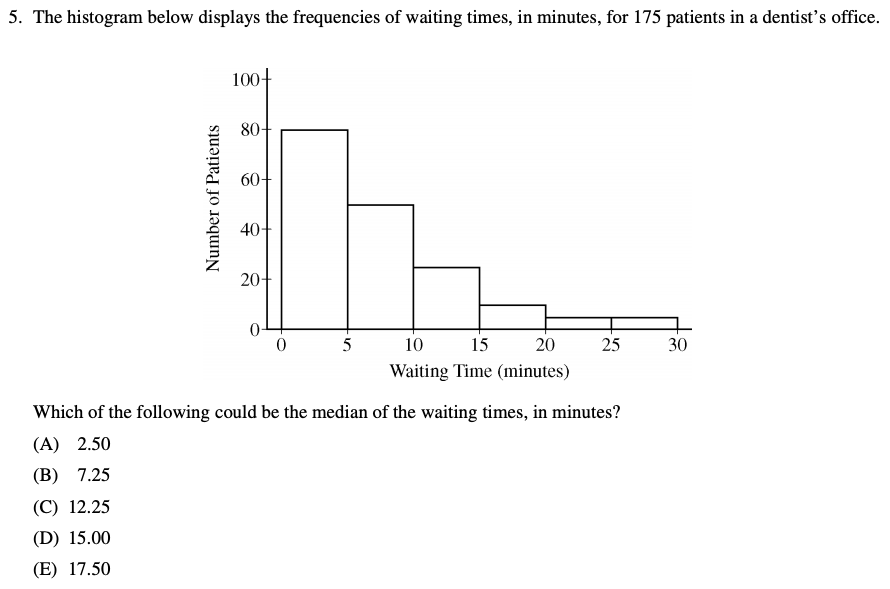
CollegeBoard 2012 AP® Statistics Examination #5
Agreement visual and numerical descriptions of data, including histograms and measures of center like median, are key parts of the AP® Statistics curriculum; they are such vital topics that they are covered in Unit 1! In this question, the creators of the test intentionally provide a skewed data set (one that is not symmetric) to assess your understanding of mean vs. median. Look at the "tail" on the correct side of this histogram. That means the median (centre information indicate) has to exist much lower than the mean (average calculated value).
What makes this fifty-fifty more catchy is a lack of real data points, so information technology is impossible to answer this question by plugging values into a calculator. You need to infer the location of the median using the sample size of 175 and finding the bar where the 88th (middle number) patient sits. While many are tempted to choice the "center" of the graph around fifteen, the median value is actually between v and 10 minutes. The respond is B, the but value in that range. You are sure to observe questions similar this on the test; be on the lookout for graphs that are skewed and do not look symmetric or normal .
#two: Which formula is correct?
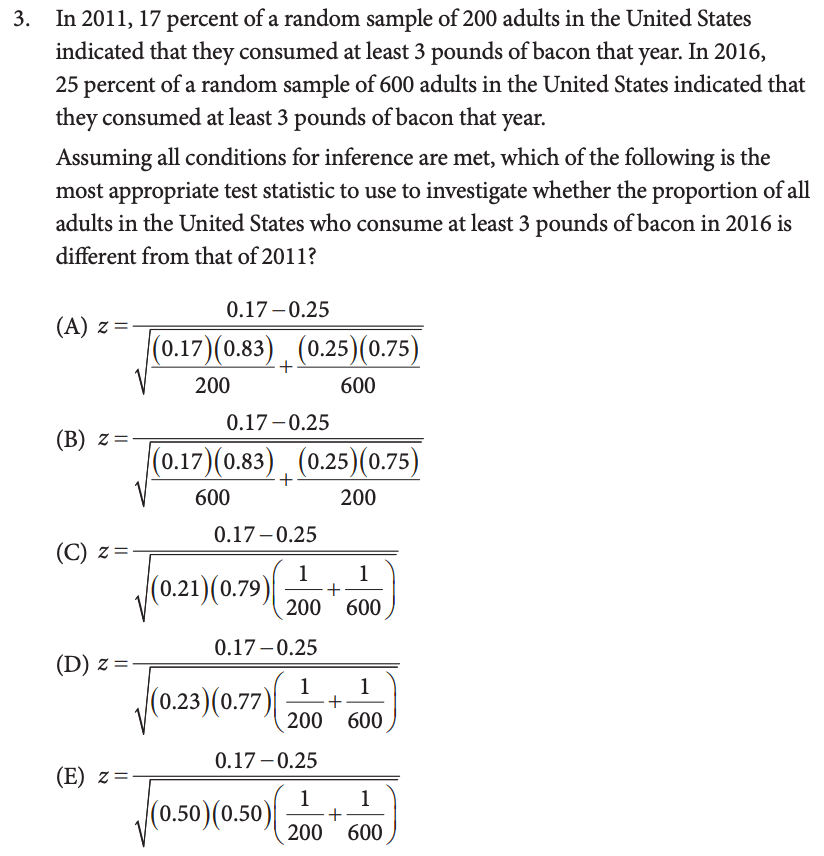
CollegeBoard 2019 AP® Statistics Course Description – MC Case #three
This question proves that a formula sheet is not necessarily your gold ticket to a 5. While yous are provided a formula sheet for the test, the writers for the AP® Statistics Exam demand to know that y'all can exercise more than plug-and-chug numbers. They want to know if yous understand when and how to use each formula. This problem is a perfect case of how they might assess your knowledge of two-sample proportions and naught hypotheses.
At offset glance, you see that you take two groups to compare, where \hat{p}_1=0.17, n_1=200, \hat{p}_2=0.25, and n_2=600. With just those numbers and your trusty formula sheet , it might be tempting to choice A… but, await!
You lot need to retrieve that this examination has the null hypothesis: p_1=p_2! That means nosotros perform calculations under the assumption that the two groups are equal, or that the null is true. And then, y'all need to combine the two samples (with 34 and 150 successes out of a total 800 adults) to notice a combined proportion of success \chapeau{p}_c=0.23. And so, and just and so, you can plug your values into the appropriate formula. The answer is D.
#3: Interpreting a confidence interval

CollegeBoard 2012 AP® Statistics Examination #22
Whatsoever figurer or estimator can churn out a confidence interval. It takes a real statistician to be able to interpret that information into an intelligible format. This is a classic question that assesses your understanding of "conviction interval", a term based on repeated sampling to capture the true parameter. The 95% here refers to the percent of samples that are successful in covering the true mean, not the percent of students or hours. Therefore, the answer is B.
This type of question appears again and again on AP® Statistics, and yous will be asked to interpret other statistical terms like P-values, slopes of regression models, correlation coefficient r, z-scores, and more than ! It isn't enough to memorize key words and phrases. You lot need to really empathise what they represent in the context of the situation. Contain some flash cards into your written report routine to actually solidify your understanding of statistical terms and make this vocabulary 2d nature.

Return to the Tabular array of Contents
Gratuitous Response Examples
We'll likewise show you a few free response questions and intermission downwards the grading rubrics ( case rubric from 2018 ) so that you can strategically tackle this section of the exam.
The scoring guidelines have remained the aforementioned since 1999. Each role of the question is scored with an E (essentially correct), P (partially correct), or I (incorrect). The combination of letter grades for each part will decide your composite numerical grade for the question: one (minimal response), 2 (developing response), 3 (substantial response), or 4 (complete response).
#i: Comparing two populations
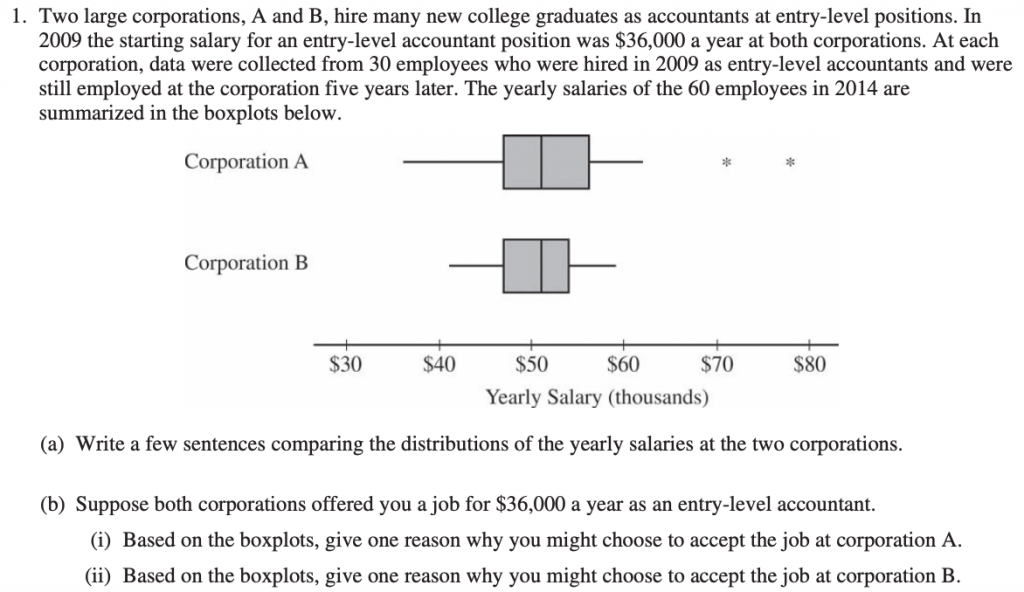
College Lath 2015 AP® Statistics Exam #ane
In this multi-part problem, you are asked to compare the salary distributions of 2 corporations based on their boxplots.
Quick tip: touch on all key features of the graphs using the acronym SOCS: shape, outliers, heart, and spread. By talking near these features in context of the problem , you would be on rails to earning an Eastward (essentially correct) for part (a).
Hither is a snapshot from the scoring guidelines for part (b):
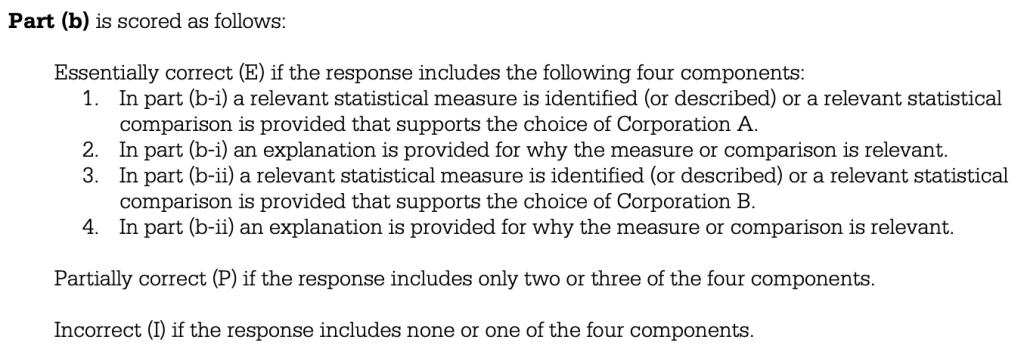
College Board 2015 Gratuitous Response Scoring guidelines
The important words here are "statistical measure", meaning y'all must specifically reference values like the median in Corporation B or the outliers in Corporation A. Yous can e'er refer to SOCS for ideas on relevant statistical measures to utilise!
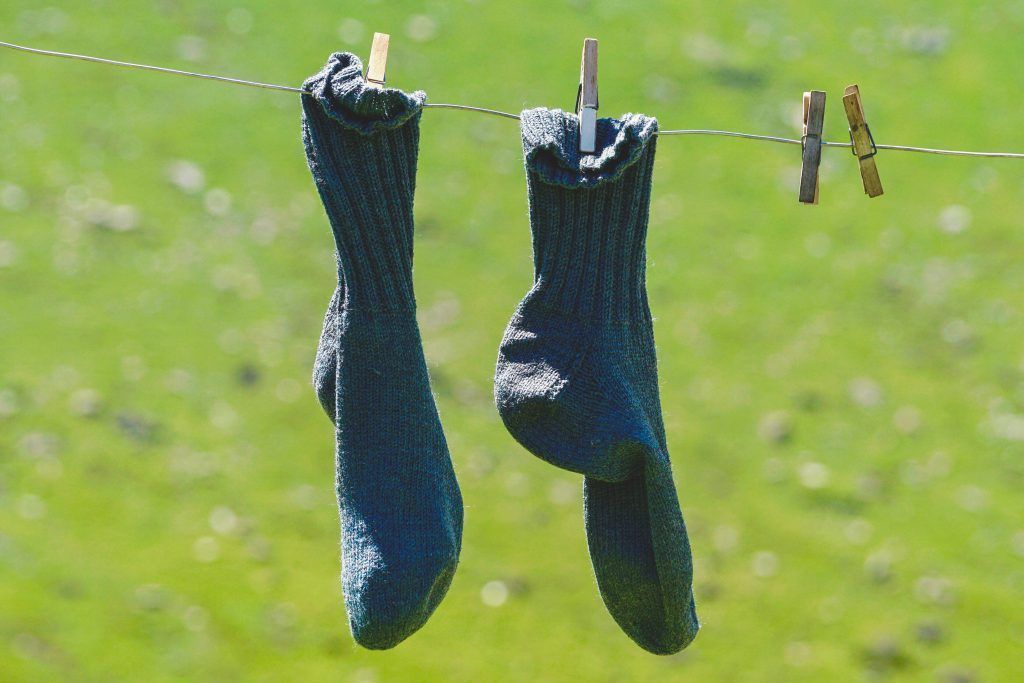
#2: Running a Total Inference Process
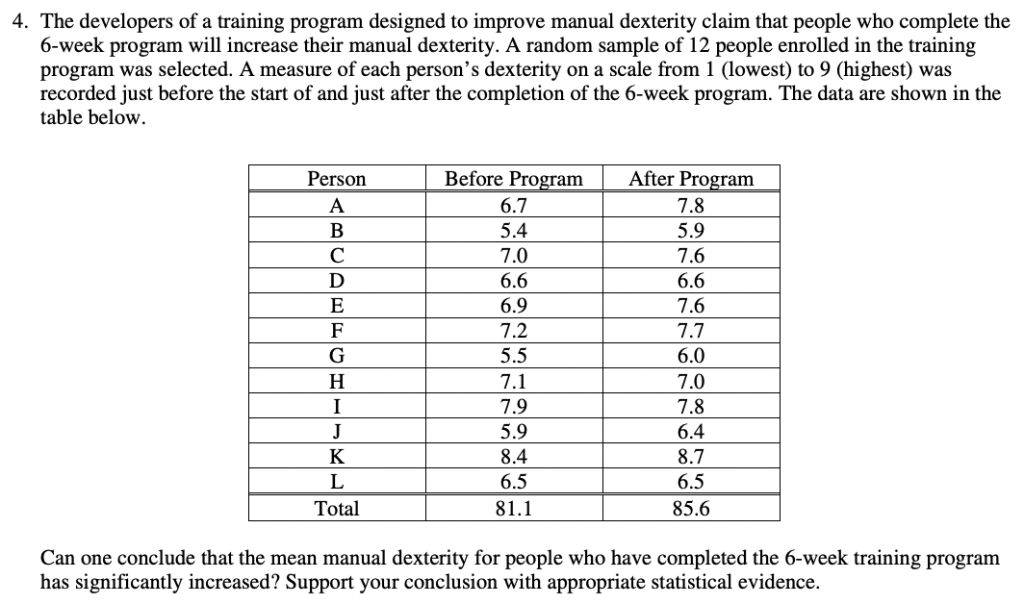
College Board 2006 AP® Statistics Test Form B #four
Many students will get this problem wrong by accidentally running a two sample t-test instead of a matched pairs t-test. What they fail to recognize is that the two groups (before and later) are dependent on the person, thus matched upwardly! If you need practice identifying statistical methods, try this interactive applet on Classifying Statistics Issues .
After ID-ing the test method, the remainder involves plugging the values into your calculator to go the paired differences and the mean + standard divergence for that sample.
The 2006 Grade B scoring guidelines details the fours steps that are necessary for every hypothesis examination yous run:
- State the correct hypotheses
- Identify exam proper noun and check for conditions
- Calculate the examination statistic and P-value
- Conclude in context
By correctly following that 4-step process for hypothesis tests, you volition cheque off all the boxes en route to earning your perfect score!
#3: Investigative Task – Multiple linear models
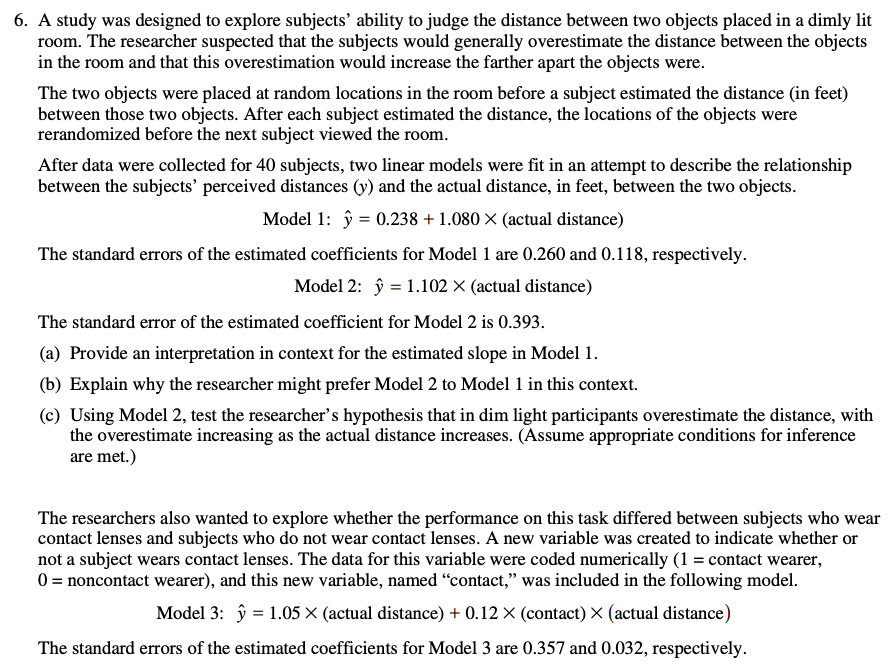
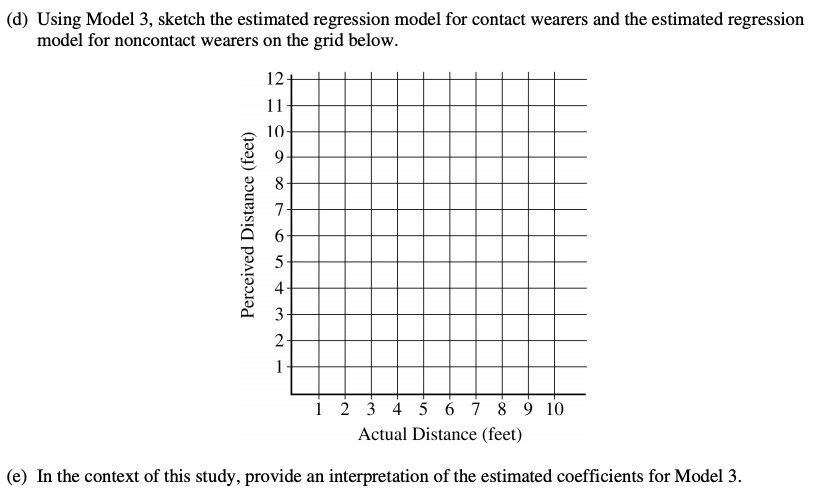
College Board 2007 AP® Statistics Exam #half-dozen
Just based on length alone, you can tell that the Investigative Task is significantly longer than other free response questions. Luckily, you are budgeted more time (25 minutes) to parse through the question and evangelize a quality response.
Quick tip: Many students programme to tackle the Investigative Task commencement in order to guarantee it gets done in fourth dimension and isn't a source of stress at the cease of the exam!
This problem demands a deep understanding of linear regression, dummy variables, and abstract thinking about the interaction of multiple variables. Looking at the scoring guidelines , you can see a focus on clear communication rather than long computations. And so make sure to explain all your thinking and provide detailed explanations of your answers.

Render to the Table of Contents
What Can You Bring to the AP® Statistics Exam?
These guidelines will help y'all blast down what to bring to the AP® Statistics Exam, and also what Not to bring! We recommend packing your bag the night before so you tin relax the morning time of the test.
DO bring these:
- No. ii pencils and erasers
- Pens with blackness or dark blue ink
- A graphing calculator with statistical capabilities (see full AP® Statistics Calculator Policy )
- A current authorities-issued or school-issued photo ID
- Your College Board SSD Accommodations Alphabetic character (if you lot are taking an exam with approved testing accommodations)
- A lookout that does not have internet access and does not make dissonance
Do NOT bring these:
- Food or drinkable, including bottled h2o
- Any electronic equipment or advice devices, including:
- Phones, smartwatches, or wearable engineering of any kind
- Laptops or tablet computers
- Bluetooth devices
- Portable listening or recording devices such equally MP3 players and iPods
- Cameras or other photographic equipment
- Devices that can access the internet
- Split up timers of whatever type
- Whatever other electronic or communication devices
- Your own cheat sail (a formula sheet will be provided)
Render to the Table of Contents
How to Written report for AP® Statistics: 7 Steps
To ensure thorough and effective review for the AP® Exam, it will take xx+ hours to complete all seven steps listed beneath. Be certain to pace yourself when studying for your AP® Stats exam, and study for no longer than 2 hours at a time. You tin cycle through steps four – half-dozen every bit many times every bit you lot feel is necessary to principal the material and develop confidence with the exam.
1. Take a full diagnostic examination (3 hours)
Time yourself to go a sense of pacing for each department, and take note of any topics or sections that give y'all trouble. You can use the official released College Board test from 2012 , take a practice test from Albert online, or buy a review book from Barron's or The Princeton Review .
two. Grade your test and prioritize topics that you need to practice (ane – 2 hours)
Y'all should take your time in this self-assessment slice to really brand the well-nigh of your written report sessions. Read carefully through the free response scoring guidelines while grading yourself, fifty-fifty reading the notes and alternative solutions.
Later, become through the topics list and highlight each item based on your level of understanding: green if you lot are highly confident in that topic, yellow if you are close to mastery, and pink for topics that you need to review and do.
three. Map out study sessions in your calendar (20 min)
Observe out how many days y'all accept before the AP® Statistics Exam day, and block out fourth dimension each day for review. Even if you but review for 15 minutes a day, that is better than 8 hours of cramming the nighttime earlier the examination. If yous tin, notice a partner to join you for your study sessions!
"Success is the sum of small efforts – repeated mean solar day in and day out." – Robert Collier
iv. Re-learn catchy concepts with notes and videos (2 – 5 hours)
Expect through summary pages in your textbook or review material from online resource, focusing on trickier topics you identified in a higher place. Mr. Holloman's AP® Statistics , Dan Shuster Affiliate Notes , and YouTube videos by Rob Tarrou are all great resource to assistance you analyze concepts you may take missed the get-go time around.
5. Do practice bug. Then do some more. (10 – 15 hours)
This is arguably the most important piece of the puzzle. Yous should exercise sample questions from isolated topics and get detailed feedback on right + wrong answers.*
You lot can pick and choose questions from released AP® Statistics Exams or AP® Statistics Review Books and build up your mental "depository financial institution" of official questions.
*An important part of this process is checking your answers and reading through the solutions carefully. If you can articulate WHY you got an answer wrong and how your understanding of the topic has changed, you will be well on your way to acing the AP® Statistics Examination.

6. Take another total test under time pressure (3 hours)
Put your newfound knowledge to the exam with another full examination, paying careful attention to fourth dimension management every bit you move through each section. You lot should upkeep about 2 minutes per multiple option problem, xiii minutes for each regular free response, and 25 minutes for the Investigative Task. Afterward, reflect on where you felt comfortable and rushed, and figure out examination sections that yous may need to study up or save for last. For case:
- Practise you run out of time when completing an Investigative Job? (We recommend doing this 2d in the free response section)
- Are you losing time typing numbers into your calculator for regression or graphical displays?
- Are you lot spending too long on multiple choice problems involving probability calculations?
Knowing your strengths and weaknesses can help you make a plan for test day then that y'all walk in feeling confident and fully prepared.
7. Rest upwardly the day before the test! (v hours)
Cycle through steps #4-6 as many times as yous can during your study sessions, but leave the twenty-four hours before the exam for some relaxation and cocky-care. Go workout, meditate, hang out with friends, swallow nutritious food, exercise some light review with flashcards, and near importantly… get a expert night'southward sleep !
*It can even be helpful to plan something fun afterwards the examination to gloat finishing AP® Stats. Grab ice cream with friends or treat yourself to a nap in the hammock!

Render to the Table of Contents
AP® Statistics Review: 15 Must Know Study Tips
five AP® Statistics Study Tips to Do at Habitation
1. Break upward your study sessions into chunks using the Pomodoro Technique .
The classic model involves setting a timer and studying for 25 min sessions with a five min break in between each session. You tin can take a longer (xxx min) break later on 4 sessions to proceed your listen fresh and productive. This will truly brand the study sessions fly past!
2. Get to know your calculator and the common functions for statistics, such as pnorm, binompdf, computing confidence intervals, and running regression models.
Here is a dandy summary page of Calculator Functions for the AP® Stats Test . This will help you save enormous time on the multiple selection department and check your answers in the free response.
3. Exercise classifying statistical inference procedures using your textbook or this applet on Classifying Statistics Problems .
Check out Stats Medic's article Name that Significance , or this great flowchart of inference from StatsMonkey for a visual representation of when to implement each exam or confidence interval.
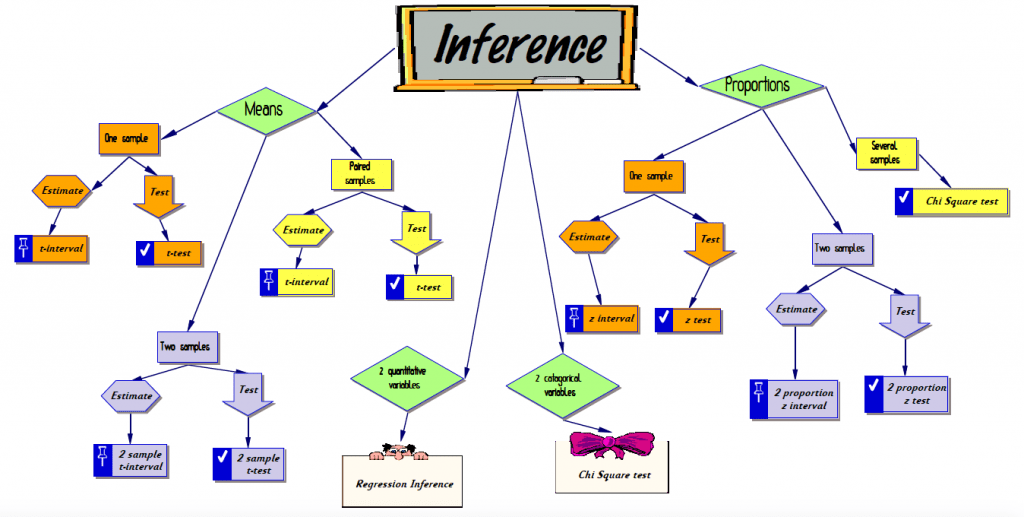
Source: StatsMonkey Inference Inspiration
4. Part of your studying tin can be annotating the AP® Statistics formula canvas and then that you know which formulas to utilize for specific topics.
Instead of memorizing things that are already provided to y'all, you should reference each practice problem to a formula on the sheet (when applicable) and make a mental map of the cheat sheet, similar this professor does for certain equations . It is a similar process to annotating a book for close reading, where you write your own thoughts and opinions in the margins to help process and retain data.
v. Practice, practice, exercise.
Reading your textbook and gaining knowledge is one thing; putting that knowledge to the test with challenging practice questions is another. As shortly as possible, outset doing multiple choice and complimentary response questions from College Board , Albert , or AP® Statistics Review Books . We hope that you make mistakes and learn from them. Utilize your teachers and peers for help when you lot get stuck, then do every bit many practice problems every bit you tin can to build knowledge and conviction.
"Don't exercise until you go it right. Practice until you lot tin can't become information technology wrong."
5 AP® Statistics Multiple Choice Tips
1. Answer every question, fifty-fifty if y'all accept to approximate.
You don't lose points for wrong answers, so before you surrender on a question completely, use the process of elimination to rule out unlikely answers and make an educated guess. NEVER leave a question blank; the same goes for whatsoever free response questions, where you lot might earn partial credit for a formula that is jotted downward correctly.
2. Focus the bulk of your studying on the topics that are more likely to appear on the exam:
For example, these topics announced the most in the multiple option section.
- Inference for proportions and means (22-33%)
- Exploring data with graphs and summary statistics (20-thirty%)
- Probability, random variables, and distributions (20-xxx%)
Other topics like experimental design, linear regression, and chi-square testing volition show up on the exam, but at a much lower frequency than those listed higher up.
three. Depict sketches of the distributions whenever possible, turning verbal descriptions into visual displays that you can translate.
This is particularly useful when it comes to calculating probabilities (with Venn diagrams or normal distributions), finding summary statistics for skewed distributions, and envisioning trends in scatterplots.

four. Practice identifying binomial variables such every bit a coin flip, free throw, or any random upshot involving: 1) repeated trials, 2) two possible outcomes, three) a fixed probability of success, and 4) independent trials.
This is a very specific probability topic that tin save you valuable time when y'all recognize it and apace calculate the respond using binompdf in your calculator.
5. Read the questions completely— no skimming.
Even with longer descriptions of experimental designs or hypothesis test interpretations, make sure to read each judgement thoroughly and empathize the scenario before looking at the answers. Some of the "distractor" answers have subtle differences that are designed to appear plausible but that actually exploit common misconceptions.

5 AP® Statistics Free Response Tips
1. Know the language of statistics and utilise common phrases like "on boilerplate", "predicted increase", or "sufficient evidence to reject the aught".
Here is an excellent handout of the Summit 10 Phrases to utilize in your Answers for AP® Statistics
2. Label everything, including graphs, formulas, random number tables, and sketches of normal distributions.
You lot don't want to lose points for lack of communication, and clear labels will keep your thoughts organized while giving you lot a shot at partial credit. This goes along with tip #three…
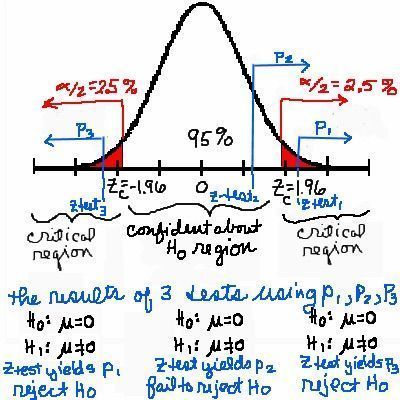
Source: mathnstuff
iii. Explicate all of your answers thoroughly and in context!
You will receive no credit for "naked answers" on the test, even if the numbers are correct (this is a common mistake on probability questions). Provide detailed explanations on your answers in context to receive full credit. For example…
- No context: "With a P-value of 0.018, we have sufficient evidence to turn down the null hypothesis at the five% significance level."
- In context: "With a P-value of 0.018, we have sufficient evidence to reject the zippo hypothesis at the 5% significance level and conclude that the manual dexterity for people who completed the half dozen-calendar week training program has, on average, significantly increased. "
4. Read through all vi questions before yous put the pen to paper and see which ones you feel confident tackling first.
We recommended doing the "easiest" problem first, then the Investigative Task, then the other 4.
Remember than you have about 13 minutes for the standard costless response questions, and 25 minutes for the Investigative Job. Proceed track of your time and write down something for every office to ensure that you lot have as detailed an caption as possible.
v. Use foreign acronyms to aid you retrieve common statistical procedures.
For example, we employ SOCS (shape, outlier, center, spread) to describe univariate distributions or FODS (grade, outliers, direction, forcefulness) to depict scatter plots.
Some others you can use:
- EMC three for constructing a confidence interval (Interpretation, Measure, Bank check, Compute, Communicate results)
- PANIC (Parameter of interest, Assumptions, Proper noun the conviction interval, Interval, Determination)
- HMC iii for running a hypothesis exam (Hypotheses, Method, Check, Compute, Communicate results)
For an fifty-fifty more than comprehensive list of tips: The Ultimate List of AP® Statistics Tips
Return to the Table of Contents
AP® Statistics Exam: 5 Test Day Tips to Remember
When exam day finally comes, information technology is normal to feel a footling jittery and anxious about the exam. Instead of last minute cramming, here are some tips and tricks for examination 24-hour interval that will help you walk into the exam feeling confident!
ane. Brand sure yous have brought the physical items that you lot need for the exam.
Forgetting your ID menu or figurer can be deal breakers, while misplacing extra erasers and watches are small inconveniences. Here's a quick checklist that you lot tin can use to brand sure you have all the essentials before you exit home.
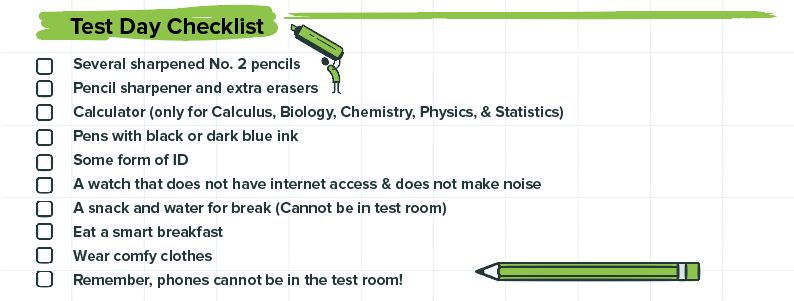
2. Watch your time and prioritize finishing the test completely.
If yous get stuck on a problem, skip it and come back to it subsequently. Give yourself fourth dimension checks to get through each function of the exam, budgeting an actress xx minutes at the cease to bank check over your piece of work, clarify explanations, and end missing problems.
3. If you cannot practice question (a) of a multi-function costless response question, no worries! You lot tin make upward a value and employ that for subsequent parts,
or explain what your process would be had you successfully answered office (a).
Remember, the examination graders appraise your piece of work holistically and are looking for areas to give you credit. If you can clearly communicate your thinking, you will be fine.
4. Beware of these common mistakes in statistics:
- Disruptive blocking (used to assign treatments) and stratifying (used to collect a sample)
- Stating that a merits is either correct or incorrect, rather than citing show that supports the claim
- Calculation standard deviations instead of adding variances when combining random variables
- Forgetting to use the words "predicted" or "on boilerplate" when interpreting slope of a regression model
- Confusing confidence levels (the proportion of successful capture) with confidence intervals (the lower and upper premises of an estimate)
- Mixing upward Type I and Blazon II Errors
- Forgetting to characterization axes and graphs
You don't need to memorize all of these, simply you should know which ones you tend to slip upwards on from previous practise tests. Proceed them in mind at the starting time of the examination and, in one case the exam begins, jot them downwards on a piece of flake paper for future reference.
5. Consume a good breakfast and relax!
Other than some light review with flashcards, you should avoid heavy studying and do what y'all can to put your mind at ease on the morn of examination solar day. Mimic an athlete the day of a big race or game. Do some light stretches, eat a salubrious breakfast, pump yourself up with positive messaging, and trust that your preparation will pay off come game time.
Render to the Table of Contents
AP® Statistics Review Notes and Do Test Resource
Here are our favorite online resources to help you prep for the AP® Statistics Exam:
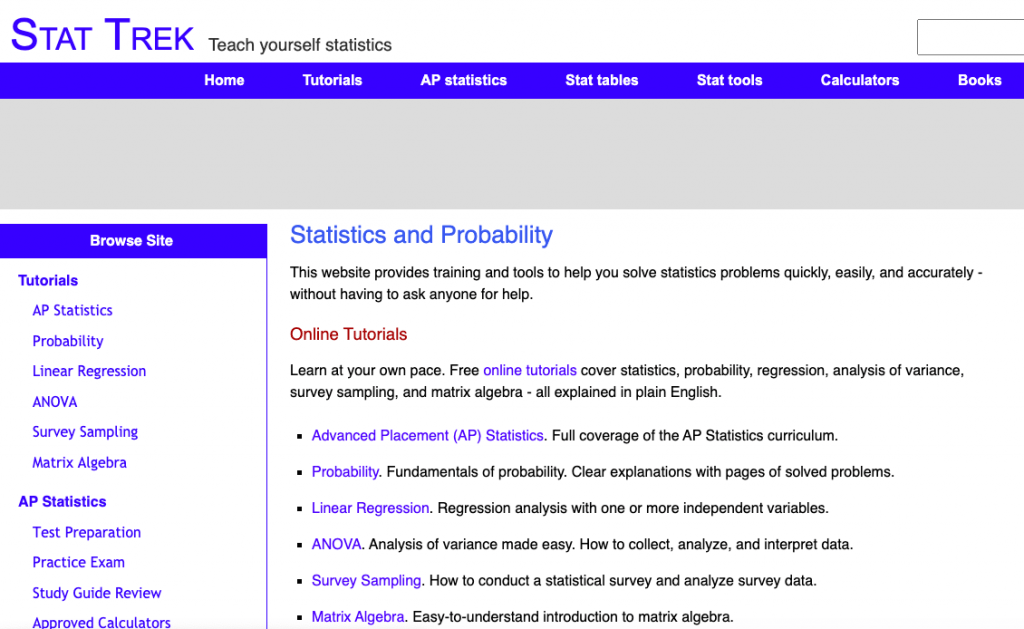
StatTrek
This website was founded by Harvey Berman, a business leader who left the corporate earth to develop an educational website that teaches people statistics… for gratis! Information technology is a i stop shop for almost everything you need to acquire statistics, interim as an online textbook for those who might not have access to a physical textbook or in-classroom resource.
- Employ this site if: you have yet to learn the AP® Stats cloth in a classroom setting and need the tools to learn independently on a budget. It includes online tutorials of the full AP® Statistics curriculum, practise questions, and online calculators with statistical functions.
- Don't utilise this site if: you are looking for a larger banking company of practice issues that mimic the format of the AP® Stats Exam.
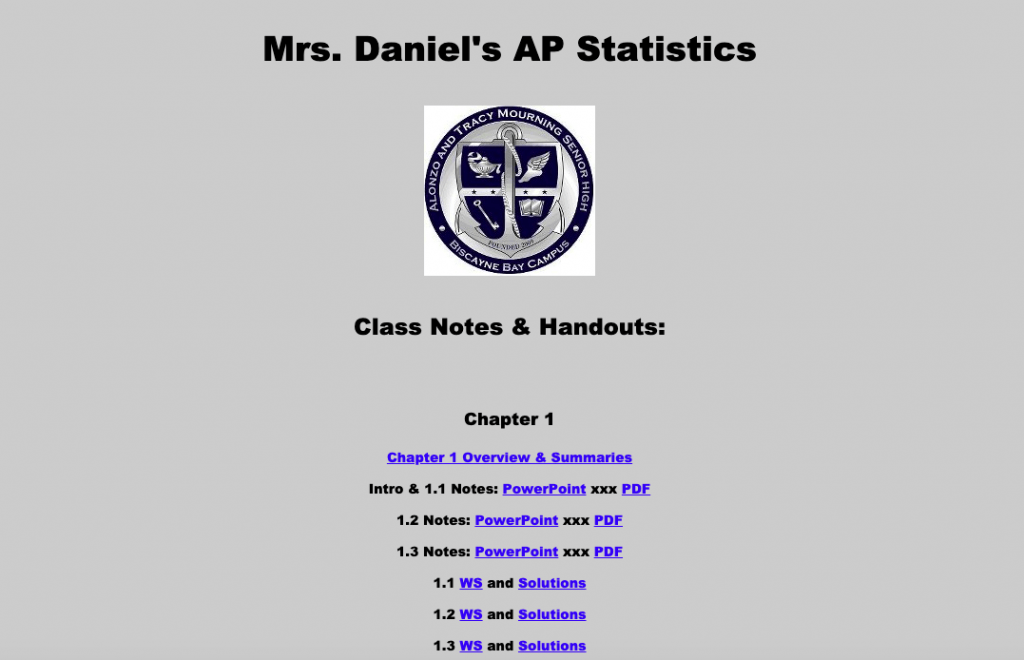
Mrs. Daniel's AP® Statistics
This site is created by a veteran AP® Statistics teacher, Stephanie Daniel, in the Miami-Dade County Public Schools district. Her materials include notes, powerpoints, worksheets (with accompanying solutions), and free-response questions for that topic.
- Utilize this site if: you want practice problems and review materials organized by topic. Information technology is especially helpful if y'all use the popular textbook The Practice of Statistics (quaternary edition) and want accompanying resources.
- Don't apply this site if: you want to learn statistical concepts from scratch with lectures or videos. Mrs. Daniel has detailed powerpoints and fill-in-the-blank notes, but without a guiding teacher to provide feedback, information technology can exist difficult to learn on your own.
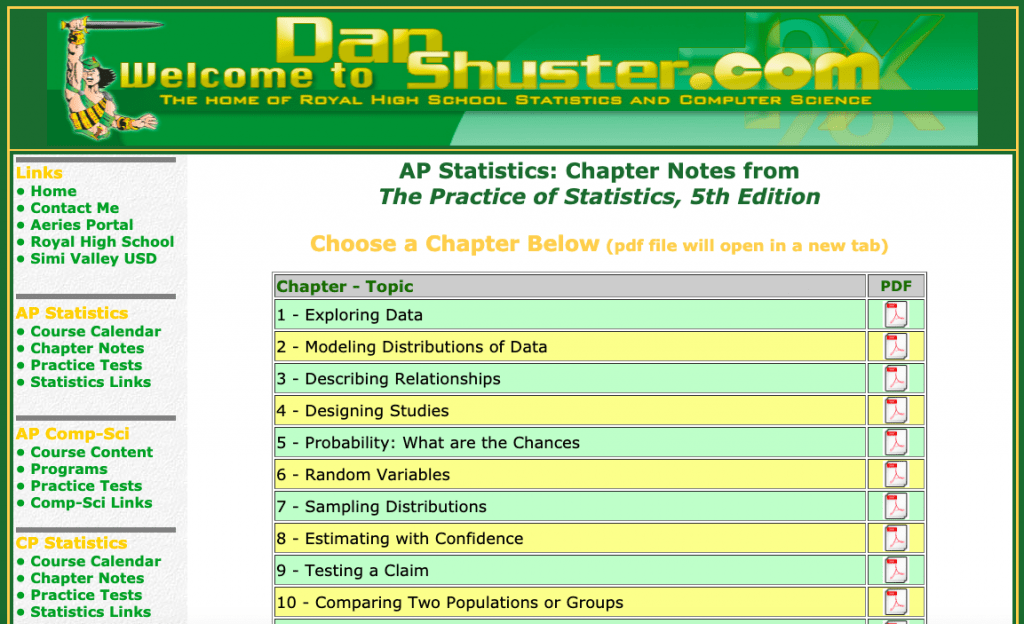
Dan Shuster
This site is created past a high schoolhouse math instructor from Simi Valley, CA and provides curtailed summary notes + practice problems for each unit of measurement. In addition to AP® Statistics, his site contains materials for Algebra, Geometry, AP® Estimator Science, and other math courses.
- Use this site if: you desire to scan through the chief points for each unit of measurement and dive into practice fabric (both Multiple Choice and Complimentary Response Questions) for those topics.
- Don't use this site if: you need more thorough explanations and feedback for the practise issues. The summary notes are essentially cheat sheets and reminders about big ideas, and the solution keys don't provide extra commentary.
Return to the Tabular array of Contents
Summary: The All-time AP® Statistics Review Guide
We've covered a lot near how you tin prepare for the AP® Statistics Test and exist confident in your skills. To wrap it all up, hither's a curtailed version of our report programme outlined above.
- The AP® Statistics Test has 2 parts and volition take 3 hours full.
The test covers topics from the following units:
- Unit 1: Exploring One-Variable Data
- Unit ii: Exploring Two-Variable Information
- Unit 3: Collecting Data
- Unit 4: Probability, Random Variables, and Probability Distributions
- Unit v: Sampling Distributions
- Unit six: Inference for Categorical Data: Proportions
- Unit 7: Inference for Quantitative Data: Means
- Unit viii: Inference for Categorical Data: Chi-Square
- Unit 9: Inference for Quantitative Information: Slopes
For more than detail on each topic, run into AP® Statistics: Form and Exam Description .
How to study for AP® Statistics: 7 Steps
- Have a full diagnostic exam
- Identify topics that want to prioritize for exercise
- Map out your study sessions in a calendar
- Learn and review concepts with notes or videos
- Exercise a LOT of practice problems and get feedback on correct + wrong answers
- Take another total test under time pressure to practice pacing
- Relax the day before the examination
Best Tips for AP® Statistics:
- Know the language of statistics and utilize common phrases similar "on average", "predicted increase", or "sufficient evidence to reject the null". Use the handout: Top 10 Phrases to use in your Answers for AP® Statistics
- Practice identifying binomial variables : 1) repeated trials, 2) 2 possible outcomes, iii) a fixed probability of success, and 4) independent trials. Once you recognize it, you lot can quickly calculate probabilities using binompdf your estimator.
- Practice classifying statistical inference procedures using this applet on Classifying Statistics Issues , supplementing that with the commodity Proper name that Significance and the visual flowchart of inference
- When completing the Complimentary Response section… practice the easiest trouble first, then the Investigative Chore, then the other 4 questions. That way you lot don't run out of time tackling the hardest (and most valuable) trouble on the test.
- Practice, exercise, practice! We can't say this frequently enough. As before long as possible, start doing high-quality and challenging practice questions from College Board , Albert , or AP® Statistics Review Books .
We promise y'all accept found this review guide helpful. If y'all follow the advice in this article and walk into the examination with a positive attitude, nosotros are 100% confident that you will be happy with your score. Good luck!
Source: https://www.albert.io/blog/ap-statistics-review/
0 Response to "Ap Statistics Exam Review Topic V Binomial Situations and Sampling Distributions"
Publicar un comentario